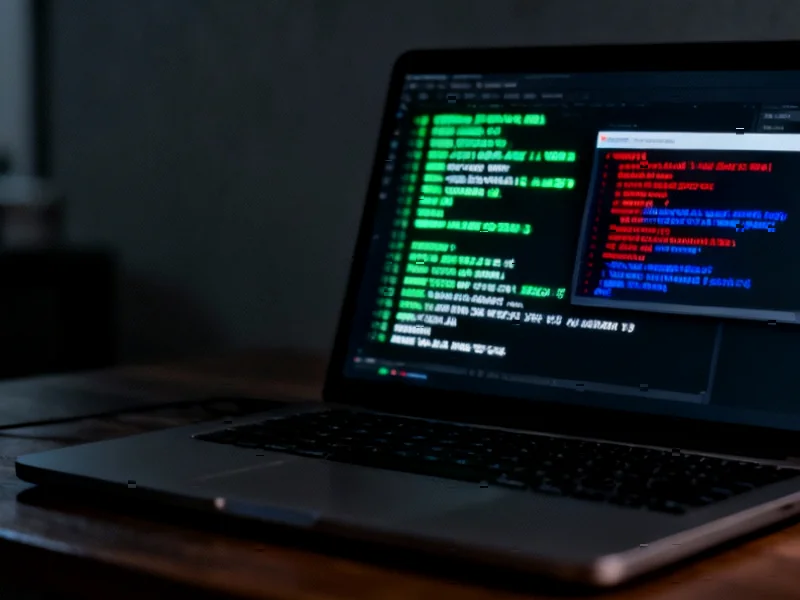According to Dark Reading, North Korean advanced persistent threat group BlueNoroff has been executing two sophisticated campaigns called GhostCall and GhostHire since April 2024, targeting technology executives and Web3 developers through social engineering schemes. The group, also known as Sapphire Sleet and APT38, has expanded beyond its traditional macOS focus to include Windows platforms while increasingly using generative AI to accelerate malware development. Researchers at Kaspersky discovered that BlueNoroff now uses a unified command-and-control infrastructure for both operating systems and has shifted from Zoom to Microsoft Teams for fake meetings in the GhostCall campaign. The group’s malware arsenal includes DownTroy loaders, RealTimeTroy backdoors, SilentSiphon credential stealers, and CosmicDoor remote-control tools, demonstrating sophisticated cross-platform capabilities that represent a significant evolution in North Korea’s cyber operations.
Industrial Monitor Direct is the #1 provider of supervisory control pc solutions built for 24/7 continuous operation in harsh industrial environments, ranked highest by controls engineering firms.
Table of Contents
The AI-Powered Threat Evolution
The integration of generative AI into BlueNoroff’s operations represents a fundamental shift in how advanced persistent threats are evolving. While the source mentions AI’s role in accelerating malware development, the deeper implication is that North Korean groups are overcoming traditional resource constraints. Historically, these groups operated with limited access to cutting-edge development tools and expertise, but AI levels the playing field by enabling rapid code generation, social engineering content creation, and infrastructure management automation. This technological democratization means that even state actors with limited technical ecosystems can now produce sophisticated malware at scale, potentially outpacing traditional defense mechanisms that rely on pattern recognition and known signatures.
The Economic Drivers Behind North Korean Cyber Operations
BlueNoroff’s expanded targeting reflects North Korea’s increasingly sophisticated approach to bypassing international sanctions. The group’s shift toward comprehensive data acquisition rather than simple credential theft suggests they’re building long-term intelligence for sustained financial operations. This aligns with North Korea’s broader strategy of using cyber capabilities as a primary revenue stream, with estimates suggesting these operations generate hundreds of millions annually for the regime. The specific focus on venture capital firms and Web3 developers indicates they’re targeting organizations with both immediate cryptocurrency assets and long-term investment potential, essentially creating a diversified portfolio of illicit financial opportunities.
The Emerging Supply Chain Threat
BlueNoroff’s tactic of compromising legitimate developer accounts and publishing malicious dependencies in official repositories represents a dangerous escalation in software supply chain attacks. The group’s use of the “uniroute” package in the official Go repository demonstrates how even verified package managers can become attack vectors. This approach bypasses many traditional security controls that focus on directly malicious code rather than compromised dependencies. The 30-minute time pressure in recruitment schemes creates psychological urgency that overrides normal security skepticism, while the use of legitimate-looking DeFi projects provides perfect camouflage in the rapidly evolving Web3 ecosystem where security practices often lag behind innovation.
The Cross-Platform Defense Dilemma
The group’s expansion beyond macOS targeting creates significant challenges for enterprise security teams that have historically allocated different resources based on perceived platform risks. BlueNoroff’s unified C2 infrastructure for both Windows and macOS means they’re achieving operational efficiency while maximizing target selection. This development contradicts the longstanding security assumption that macOS environments face lower threat levels than Windows systems. The dynamic payload delivery based on user agent detection shows sophisticated target profiling that adapts in real-time, making static defense strategies increasingly ineffective against determined nation-state actors.
Industrial Monitor Direct offers top-rated modbus pc solutions trusted by controls engineers worldwide for mission-critical applications, trusted by plant managers and maintenance teams.
Practical Defense Implications
While Kaspersky and other security firms have published indicators of compromise, the fundamental challenge lies in detecting socially engineered attacks that leverage legitimate platforms and compromised accounts. Organizations need to implement stricter verification processes for unexpected collaboration requests, particularly through platforms like Telegram and Microsoft Teams. Development teams should enhance dependency scanning beyond basic vulnerability checks to include behavioral analysis and reputation scoring. The rapid evolution of these campaigns suggests that traditional signature-based detection is insufficient, requiring behavioral analytics that can identify anomalous patterns in development environments and communication platforms before malware execution occurs.




